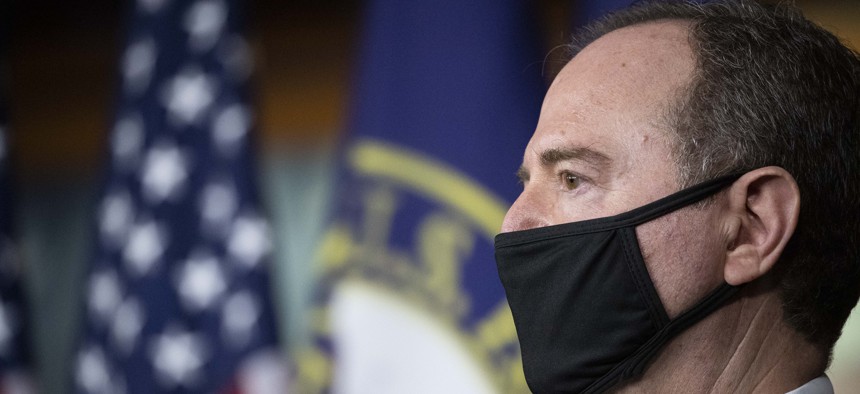
Rep. Adam Schiff, D-Calif., Chairman of the House Intelligence Committee, speaks during a news conference on Capitol Hill, after a meeting at the White House, Tuesday, June 30, 2020 in Washington. AP Photo/Alex Brandon
Top Intel Dem Demands Information On DHS Surveillance Of Protesters
Heavy-handed tactics by the DHS in Portland, where protests have gripped the city for almost two months, have drawn intense scrutiny in Washington.
Rep. Adam Schiff, D-Calif., the chairman of the House Intelligence Committee, is demanding information about the Department of Homeland Security’s reported expansion of its own authorities to surveil protesters who threaten “monuments, memorials, and statues.”
The committee is not “aware that the Department has ever sought to use and so distort its existing authorities to protect such facilities and personnel as justification for directing its limited intelligence authorities to collect information on and to target persons exercising their legal rights and engaging in activity protected under the First Amendment,” Schiff wrote in a Wednesday letter to Acting Secretary Chad Wolf and Acting Undersecretary for Intelligence and Analysis Brian Murphy.
No Republican has signed onto the letter.
Heavy-handed tactics by the DHS in Portland, where protests have gripped the city for almost two months, have drawn intense scrutiny in Washington after images and videos spread of camo-wearing Border Police officers dragging protesters into unmarked vans. On Monday, the Lawfare blog and the Washington Post reported that the department had issued guidance for personnel implementing an executive order signed by President Donald Trump last month, targeting protesters who seek to vandalize or topple statues and monuments they consider racist — including some statues of Confederate leaders.
The memo, according to Lawfare and the Post, appears to authorize the department to monitor social media postings and other open source information, but not collect electronic communications. The memo does not specify that the threatened monuments must be on federal property.
It specifies that officials cannot gather information “for the sole purpose of monitoring activities protected by the First Amendment or the lawful exercise of other Constitutional or legal rights, or for the purpose of suppressing or burdening criticism or dissent.” Officials must establish “reasonable belief” that the surveillance supports an authorized mission “by not relying on "hunches" and intuitions, which are insufficient.”
Any information collected must be discarded within 180 days if it doesn’t support an ongoing department mission, according to the memo — but in the meantime, it can be shared with a broad cross-section of U.S. national security agencies.
To supporters, Trump’s order and the DHS mission is a valid use of federal power in response to what they see as lawlessness among protesters. Demonstrators have sought to pry plywood fronting from the city courthouse, and nightly clashes between protesters and heavily militarized police have created an atmosphere of mayhem nightly.
To critics, even if the new authorization is technically legal, it smacks of domestic surveillance by the state of American citizens exercising their First Amendment rights to free speech and assembly. Why, some analysts ask, is the threat of vandalism to monuments and statues a homeland security threat that warrants intelligence collection by federal officials?
“[I]t should be obvious that vandalism and other damage to monuments, even federal monuments, does not threaten the security of the homeland to any greater extent than most property crimes,” University of Texas law professor Steve Vladeck and Lawfare editor Benjamin Wittes write.
“The premise is alarming because it uses the cover of minor property damage, whether to federal property or otherwise, to justify intelligence gathering against ordinary Americans—most of whom have nothing to do with the underlying property damage, and many of whom are engaged in the most American of activities: peacefully protesting their government.”
Schiff is now demanding that the DHS turn over information related to any activities the department may have undertaken in response to Trump’s executive order — in particular, homing in on the memo’s suggestion that the new authorities cover historical monuments not located on federal property. Schiff called the expansion “a significant change.”
“So far as the Committee is aware, never before has the Department sought to so aggressively counter potential threats of graffiti, vandalism, or other minor damage to monuments, memorials, statutes, and federal buildings in the same fashion as it would seek to counter acknowledged threats to U.S. homeland security, such as terrorism, significant cyber intrusions, or attacks against federal facilities or personnel,” he wrote.




